Marilyn Turk's Blog, page 5
March 18, 2021
Oops. Sorry for the multiple sends!
Hey folks,
I hope you aren’t upset with me for getting multiple posts today. I didn’t think it went out the first time, so tried and tried again.
But obviously, I was wrong and it did go out the first time, so please accept my apologies for sending it to you more than once.
Marilyn
Iced Over at Spectacle Reef
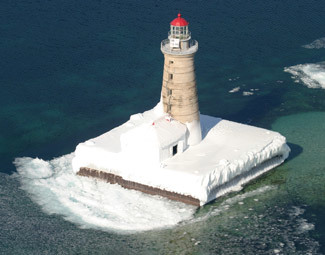
Spectacle Reef, photo courtesy lighthousefriends.com.
Located in Lake Huron, Spectacle Reef is subject to the conditions of the Great Lake. From December through March, the lake is covered with ice. The lighthouse keepers played roulette trying to guess when it was time to go back to the mainland, since shipping stopped during that time on the lake. When winters came early and with brutal temperatures, keepers could find themselves stranded with no way out.
Such was the case in December 1927, when the three keepers were trapped inside the lighthouse for four days. Thick ice covered the lighthouse, blocking the tower’s doors. On December 14, 1927, the crew of the Poe lightship arrived to rescue them. The keepers’ only way out was by crawling through a two-foot window high in the tower, from which they were lowered to the ship by a rope.
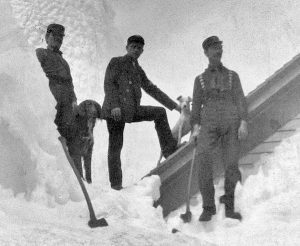
Keepers arriving to open lighthouse, 1902, photo courtesy National Archives
In late March 1972, the keepers were taken to the lighthouse for reopen it for the season by the Coast Guard cutter Sundew. The cutter was forced to ram through the ice surrounding the lighthouse before they could reach the structure. Once they reached the lighthouse, the ship sent some of its crew on the crew to chop thought about five feet of ice before they could reach the door. Once inside, the keepers slept in sleeping bags the first week until the furnace finally raised the inside temperature to sixty-five degrees. It wasn’t until the first of July first that the last piece of ice finally melted off the northwest side of the pier.
In May 2014, the lighthouse was deemed excess by the Coast Guard and has since suffered neglect until it was sold at auction. The property is now managed by the Spectacle Reef Preservation Society, who plan to restore the lighthouse to its former glory. According to their website, https://spectaclereef.org.

Spectacle Reef now, without ice, waiting for rebirth, photo courtesy lighthousefriends.com
“The goal of the Society is to restore Spectacle Reef and open it to the public as a “Learning Light” and museum where people can discover not only the history of this unique structure but also the service and sacrifice of those who manned it to keep others safe. The restoration will be a multi-year project with the plan of being operational in time to celebrate Spectacle Reef’s 150th anniversary in 2024.”
Part of the Society’s goals is to “Establish full time keeper programs on site during the operating season to educate visitors and continue restoration and maintenance projects.”
If you would like to help them accomplish their worthy, ambitious goals, your contributions are welcome, as well as any hands-on work you can do. They promise you will not be ice-bound in the process.
There is a time for everything, and a season for every activity under the heavens: … a time to tear down and a time to build.” Ecclesiastes 3:1,3b
March 11, 2021
How to Find Joy in Writing Even When It’s Not Fun
Call me a rebel. Or a hypocrite. Or even a fake.
But the truth is, I don’t always love writing. What, you say?
Aren’t writers supposed to love writing? Now I know some do, but I doubt even those who do love it don’t love it all the time. Some authors even say they can’t not write. However, that feeling is not universal among writers.
Why not? I mean, look at all the perks. You get to sit home in your pj’s if you want. You don’t punch a clock because you can write whenever you want. And then your book is published and you’re famous and rich. Right?
Wrong. Let’s look at why writing might not be fun:
You ask yourself, “Why am I doing this?” Why indeed? So, let’s look at what makes it fun:
But the biggest joy for a Christian author is knowing you’re doing what God wants you to do—write.

“We write this to make our joy complete.” ! John 1:4
So what about you? Does writing make you joyless or joyful? Why?
January 15, 2021
Writing with Ernest

Ernest Hemingway1
Ernest Hemingway was not my favorite author, in fact, I haven’t read most of what he’s written, but despite my own knowledge of his work, he was a successful author. And he was a serious writer.
Hemingway had several interests – fishing, hunting, boxing, cats and perhaps you could add women. But he had no doubt that his priority was writing.
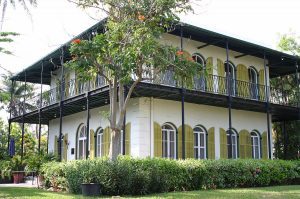 I recently had the opportunity to tour the house where he lived in Key West, Florida, which therefore piqued my interest about him. I learned he was a newspaper journalist who covered wars, that he in fact served in World War I, and that he took his writing seriously.
I recently had the opportunity to tour the house where he lived in Key West, Florida, which therefore piqued my interest about him. I learned he was a newspaper journalist who covered wars, that he in fact served in World War I, and that he took his writing seriously.
He had a colorful personality and a lifestyle I would not want to live. We differ on morals and spiritual beliefs. In fact, the only things we truly have in common are a fondness for cats, the tropics, and writing.
Hemingway knew about writing. He was passionate about and committed to his work. He got up at the same time every day, went to his office and wrote until noon. He did not worry about how many words he wrote, just that they were good words. And he had certain techniques and beliefs about writing that can also be adapted by any writer. I’d like to share with you some of his quotes about writing, some you may relate to as well.
“We are all apprentices in a craft where no one ever becomes a master.”
“There’s no rule on how it is to write. Sometimes it comes easily and perfectly. Sometimes it’s like drilling rock and then blasting it out with charges.”
“I love to write. But it has never gotten any easier to do, and you can’t expect it to if you keep trying for something better than you can do.”
“Writing is something that you can never do as well as it can be done. It is a perpetual challenge, and it is more difficult than anything else that I have ever done—so I do it. And it makes me happy when I do it well.”
In answer to ‘How much should you write a day?’ Hemingway said, “The best way is always to stop when you are going good and when you know what will happen next. If you do that every day when you are writing a novel, you will never be stuck.”
“I never use a word without first considering if it is replaceable.”
“There is nothing to writing. All you do is sit down at a typewriter and bleed.”
“Write hard and clear about what hurts.”
“The hard part about writing a novel is finishing it.”
“If a writer stops observing he is finished. Experience is communicated by small details intimately observed.”
Every writer is gifted to write in their own special way. We are not called to write like Ernest Hemingway. Or for that matter F. Scott Fitzgerald, Virginia Woolf, Mark Twain, Charles Dickens or others. However, we can glean from the writing techniques and habits they had. Even the apostle Paul had his own writing style and said so in 2 Thessalonians 3:17, “I, Paul, write this greeting in my own hand, which is the distinguishing mark in all my letters. This is how I write.”
December 23, 2020
Christmas at an Offshore Lighthouse in the UK
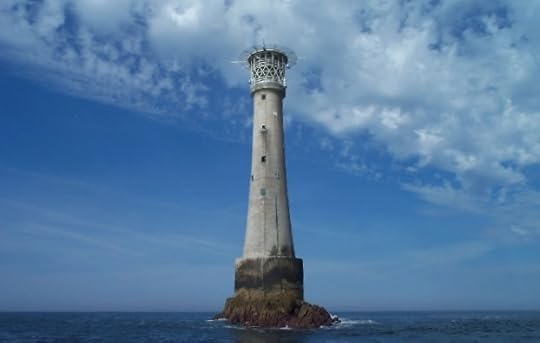
Bishop Rock, photo by Richard Knights, Creative Commons
Have you ever wondered what it was like to be a lighthouse keeper at Christmas at one of the isolated lighthouses in the middle of the water? Here’s a story about how some lighthouse keepers in the United Kingdom spent Christmas.
It was early December 1969, and time for the lighthouse keeper to return to the lighthouse and relieve another keeper. His last three weeks at home would have to suffice for the holidays because he would not be home for Christmas.
The keeper boarded the helicopter that would take him six miles out in the Atlantic Ocean to a lone lighthouse, noticing the dark sky and the howl of gale force winds. Boxes of supplies containing enough food to feed three keepers for a month plus some extra treats were loaded onto the chopper along with him.
Buffeted by the wind, the helicopter made it to the lighthouse and landed on the small helipad on top. The boxes were unloaded and lowered through hatches in the landing platform to the keepers that waited below, while the keeper who was going home climbed into the helicopter and took off.
At the lighthouse, the keepers emptied the boxes and stored the meat in their fridge. They discussed news at home and from other lighthouses. As they opened boxes, they found a letter from the local rotary club who had sent a Christmas gift for all of them.
They’d received all they needed for their Christmas meal—meat, potatoes and even a cake. Everything else in the box was in threes—three tins of fruit, three small Christmas puddings, three stockings of oranges, apples and nuts, so that each man received an equal share of goodies. In addition to the rotary club, the keepers got other treats from churches or school groups who also sent letters and cards to let the keepers know they had not been forgotten. In addition, the keepers received presents from their own families back on the mainland.
The lighthouse was decorated with streamers and Christmas cards they had received, plus an old artificial Christmas tree that they brought out of the closet once a year.
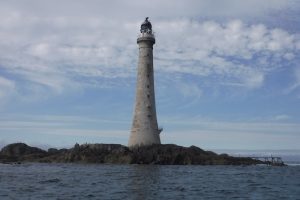
Skerryvore lighthouse
On Christmas Day, the keepers greeted each other in the kitchen at breakfast and exchanged small gifts. Next, they unwrapped presents from their families while back on the mainland, their families were also opening presents. The keeper who was the “cook of the day” returned to get dinner ready while the other two left the kitchen to telephone their homes and wish them Merry Christmas.
When the three lighthouse keepers finished their noontime Christmas dinner, they helped clean up the kitchen. Afterward, they retired to the lighthouse sitting room where they donned colored paper hats and pulled Christmas crackers. Then they lit cigars and poured beverages to sit back and watch the queen’s speech on the “telly.”
When the queen’s speech was over, the men turned on the radio transmitter. Ever since radio was introduced to the lighthouses, a tradition began that on the afternoon of Christmas Day, each lighthouse would use a special frequency to call other lighthouses, some up to a hundred miles away, spreading Christmas joy by singing Christmas carols to each other. Some of their families back home listened to the same frequency, enjoying a unique time of “togetherness.”
Too soon, the holiday celebration was over, and the keepers returned to their duties. The engine that runs the light was started, the curtains around the lantern room were removed and the electric motor that begins the rotations of the light was turned on so it would be seen by ships out at sea.
After the light was activated, the keepers sat down to enjoy fresh hot tea and finally cut the Christmas cake which they ate with bowls of fruit and cream. Perhaps it wasn’t the best way to spend Christmas, but they were still able to enjoy the holiday. And hopefully, the next year, they would be able to enjoy it at home with their families.
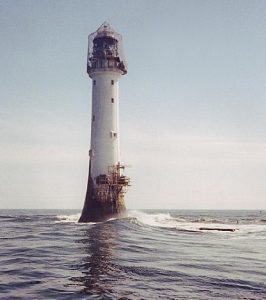
Bell Rock Lighthouse
“In the same way, let your light shine before others, that they may see your good deeds and glorify your Father in heaven.” Matthew 5:16
November 25, 2020
A Thankful Lighthouse

Photo courtesy lighthousefriends.com
The lighthouse at the entrance to the Tchefuncte (pronounced “she funk tee”) River was built in 1837 to guide ships across Lake Ponchartrain, Louisiana, to the port in Madisonville, Louisiana.
Built on low-lying land, the area of the lighthouse and its other buildings like the keeper’s house, the fog signal, outside kitchen, woodshed and outhouses, were subject to flooding during storms. More than once the breakwater around the lighthouse area was rebuilt over the years.
The swampy area of the lighthouse provided pets for one keeper. Benjamin Thurston, the first keeper of the lighthouse, had pet alligators.
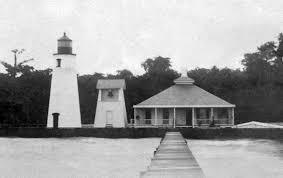
Photo courtesy US Coast Guard
Frederick A. Schrieber, who served as keeper from 1920 to 1935, lived at the lighthouse with his wife Lilla and their seven children. Schrieber had to pay seventy-five cents a day for his children to take the ferry to school, which was quite expensive during that time. A visiting inspector requested that the government pay the fare which would be cheaper than hiring a teacher to live at the lighthouse station at a monthly salary of $30.
In July 1915, a hurricane struck the station when seventy-three-year-old Keeper Joseph P. Groux was in his twenty-sixth year of service at the lighthouse. The Secretary of Commerce commended Keeper Groux for maintaining the light under hazardous and trying conditions.
 The last keeper left in 1939, and the light was solarized in 1952, and the keeper’s cottage was sold and moved into the town of Madisonville where it was used as a private office. The lighthouse was neglected and a target of vandals until the town gained ownership of the property from the Coast Guard in 1999. A group of volunteers formed with plans to restore the lighthouse, and in 2008, the first phase of its efforts began with repairing and repainting.
The last keeper left in 1939, and the light was solarized in 1952, and the keeper’s cottage was sold and moved into the town of Madisonville where it was used as a private office. The lighthouse was neglected and a target of vandals until the town gained ownership of the property from the Coast Guard in 1999. A group of volunteers formed with plans to restore the lighthouse, and in 2008, the first phase of its efforts began with repairing and repainting.
This month, after years of effort by the town of Madisonville and the volunteer organization, the lighthouse has received a special gift. The Gulf of Mexico Security Act is sending $1.6 million to shore up the Tchefuncte River Lighthouse and the eroded land around it. Plans are in place to add a pier to the property so that tourists may visit the lighthouse when the restoration is finished.
The Tchefuncte River Lighthouse is a very thankful lighthouse this Thanksgiving.
“Give thanks to the Lord, for He is good.” Psalm 118:29
July 4, 2020
Patriotic Memories at the Lighthouse
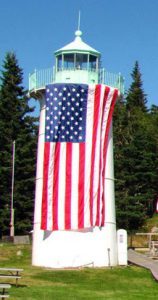
Little River Lighthouse, Cutler Maine
In July, 2013, my husband and I had the privilege of being honorary lighthouse caretakers at Little River Light on an island off the coast of Cutler, Maine.
A dream come true, I’ll never forget the experience we had for ten days on the island.
We were hosts for overnight guests who stayed a night or two in one of the three upstairs bedrooms of the keepers house. We transported them from the mainland to the island, as well as, kept the property cleaned and the yard mowed. Not exactly a bed and breakfast because the guests brought their own food and bedding, we cooked our meals separately, but often shared our mealtimes or morning coffee with our guests.
What a delight it was to meet so many different people from various places in the country and the world!. The flag you see there on the lighthouse was unfurled for special occasions – the fourth of July and the inter-congregational church service that was held one Sunday one the island during the summer. I’m so glad we were there at that time. Kathleen Finnegan, managing editor of Lighthouse Digest, asked me if I wanted to help unfurl and attach the flag on the lighthouse, and of course, I jumped at the opportunity.
All morning that Sunday, lobster boats ferried people across the harbor to the island. The people arrived with folding chairs and umbrellas, while the minister and musician set up under a large open tent. The temperature was unusually warm that day – close to 80 degrees – which was too hot for these Mainers. Funny that the next week, the temperature changed once again and we needed to use space heaters to warm the keeper’s house. That’s the way things are on an island in the Bay of Fundy. Tides rise and fall, days go from hot to cold and from clear to foggy. In fact, it seemed like we experienced three of four seasons while we were there during July!
This picture of the flag-draped lighthouse represents America to me on so many levels. The lighthouse is part of our history, a beacon that guided mariners and fishermen into safe harbor. The people of Cutler are small-town folk, the type who watch out for their neighbors and keep an eye on things, Americana in its truest form. They knew when strangers (us) were on the island and kept track of our comings and goings. I have no doubt that if we’d needed help, help would’ve appeared instantly. Although we had no phone service to the mainland, we were able to listen to the marine radio which the lobster boats used to communicate to each other. We heard the latest news about the local little league, whose lobster traps were tangled and what their families were going to do that weekend. I also heard them joke about my husband trying to catch fish near the island, which he did, in fact.
I’m so thankful we had the opportunity to enjoy this slice of America, an experience not available these days. And how appropriate to represent our nation by displaying our flag during an interdenominational church service. God and country. That’s what we celebrate. God Bless the USA.
“Blessed is the nation whose God is the Lord,” Psalm 33:12a
May 30, 2020
Lighthouses on Lockdown
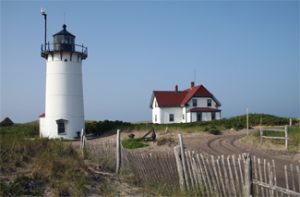
Race Point Light, Cape Cod, MA, photo courtesy lighthousefriends.com Closed for overnight stays summer 2020.
With the threat of the COVID virus pandemic, most everyone has been affected in some way.
Our lives have changed, and our futures questioned. For those of us housebound, we’ve hoped for summer vacation as an escape from work and homeschool. Unfortunately, many of us have had to cancel or adjust our vacation plans as well.
Thankfully, there’s been some letting up on restrictions, and we’re seeing some national and state parks reopen. Amusement parks may still open at some point this summer, but some places may not open this year at all.
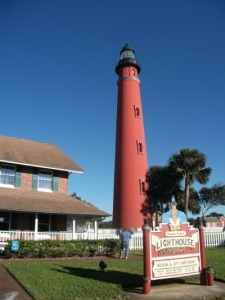
Ponce Inlet Lighthouse, FL, photo by Chuck Turk. Now open
Among those are many lighthouses. Each state has its own regulations, and lighthouses are subject to them. What’s important to remember, however, is that not all lighthouses are under the same management. Some are state-run, some belong to national parks, while others are privately funded and maintained. Most all of them are supported by volunteers who contribute their time and effort out of their love for lighthouses.
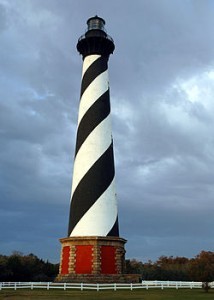
Cape Hatteras Light, NC, photo by Chuck Turk. Currently closed.
Lighthouses that normally open for the summer depend heavily on the income gained by fees for climbing as well as museum and gift shops. These fees provide much-needed funds to make repairs, paint, and supply the lighthouses with necessary equipment.
If you were planning on visiting a lighthouse this summer, please check their respective websites or Facebook pages to see if they’re open. So far, a few in Florida have opened with social distancing restrictions. Others may open a bit later than normal.
If you can’t visit, please consider giving a donation to the entity that manages that particular lighthouse and do your part to keep the lights shining.
“In the same way, let your light shine before others, that they may see your good deeds and glorify your Father in heaven.” Matthew 5:16
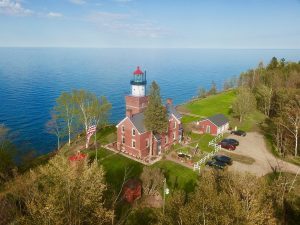
Big Bay Point Lighthouse B & B, Michigan, photo courtesy Nick Korstad. Now Open
May 25, 2020
Memorial Day at the Lighthouse
Republished from 2014
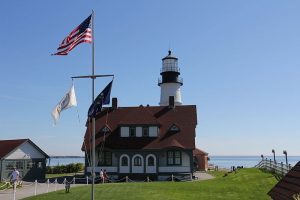
Portland Head Light photo by Royalbroil, courtesy Wikimedia
“Here they come!” Nine-year-old Tommy shouted from the front porch.
Polly dried her hands with the dish towel and followed Emily, Tommy’s little sister, to the front door.
Sure enough, coming over the top of the hill were men, women and children toting blankets, chairs and baskets. They surveyed the area, then claimed their spots to set up for picnics.
“Look at all the boats!” Emily pointed toward the water.
They turned their heads in unison to see boats of various types and sizes putting down anchors or pulling into shore where possible. Sailboats and motorboats displaying American flags dotted the bay and shore.
Polly couldn’t help but feel her children’s contagious enthusiasm. She was excited to see people too. After months of isolation at their remote lighthouse home, she was eager to welcome civilization again.
It was Memorial Day weekend, the beginning of summer vacation time. For the next three months, the “summer people” would arrive daily. Some would stay the whole season in their cottages, while many others came for just the weekend or a day’s outing.
Picnics, cookouts, and lobster feasts, accompanied by laughter and fun, were a welcome change from long, lonely days of fog and cold. The lighthouse was a major attraction to the area, so Polly expected curious visitors to stop by, interested in seeing how lighthouse families lived.
[/fusion_builder_column]
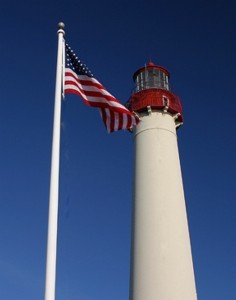
Cape May Lighthouse with flag, photo by Chuck Turk
“Let’s go raise the flag. Would you like to help me?”
“I will! Let me!’ Tommy raced to the flagpole.
“Me too!” Emily ran behind.
As Polly helped the children hoist the flag, her heart swelled with happiness.
When the flag reached the top, Polly put her hand over her heart and said, “Ready, salute,” and she and the children recited the Pledge of Allegiance together.
“Momma, do we have Memorial Day to start summer?” Tommy asked.
The question jolted Polly as she realized how he had made the connection.
“Oh no, Tommy. Memorial Day means much more than that. It’s the day we honor those people who gave their lives serving our country. People like my grandfather died fighting for us so we could be free.”
Tommy gazed up at the flag waving in the breeze. “My teacher said the flag represents freedom.”
“That’s right.”
“So they died so we could raise our flag.”
“I suppose you’re right.”
“And that’s why all these boats have flags too, to celebrate freedom?” Tommy motioned to the vessels in the water.
“I hope so, son. I hope so.”
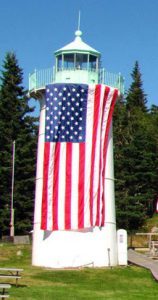
Little River Light, photo by Chuck Turk
Thank God for the freedom we have and for the men and women who died to give it to us.
And thank God for the spiritual freedom Christ gives us.
“It is for freedom that Christ has set us free.” Galatians 5:1
May 10, 2020
What do you give a Lighthouse Mother?
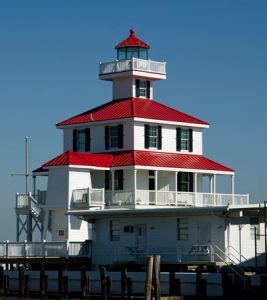
New Canal Lighthouse, Flickr, Creative Commons, photo by hatchski
What kind of a Mother’s Day gift do you give to a woman who took care of hundreds of people while tending a lighthouse at the same time?
Margaret Norvell, who served as a lighthouse keeper at three different lighthouses in Louisiana, was a “mother” to many for 41 years. With two small children, Margaret took over her husband’s duties as keeper at the Head of Passes Light Station after his death in 1891. In 1896, she was appointed keeper for the Port Ponchartrain Light Station and also tended the New Canal Light.
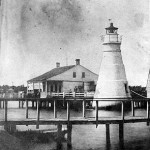
Port Ponchartrain Light Station, photo courtesy USCG
In addition to keeping the light functioning and the fog bell ringing during all kinds of weather, Margaret personally rescued many. Crews of overturned schooners and yachts, passengers of a ferry that caught on fire, and even a pilot whose plane crashed into the lake during a squall were saved by her heroic efforts.
Her caregiving extended beyond the duties of a lighthouse keeper. In 1903, a devastating hurricane hit the area, its wind and rain destroying every building in the community except the lighthouse. Margaret provided shelter for over 200 people left homeless by the storm, and even started a relief fund to help them get back on their feet.
So how do you honor such a devoted woman who gave to so many others?
In June, 2013, the U.S. Coast Guard, who now oversees lighthouses, recognized Margaret by naming a Fast Response Cutter after her, the first of its class to be named for a woman. The Margaret Norvell was commissioned in New Orleans where Margaret served, and I had the honor of being invited to the ceremony. Although Margaret passed away in 1934, many of her descendants were on hand to celebrate Margaret’s distinction and pay tribute to her memory.
Margaret would nave been amazed. And so pleased.
“Many women do noble things, but you surpass them all.” Proverbs 31:29
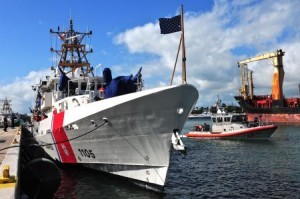
USCG Cutter Margaret Norvell, photo courtesy USCG


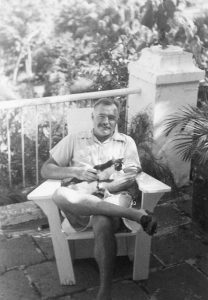
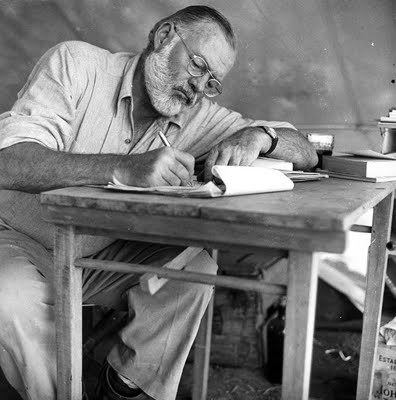
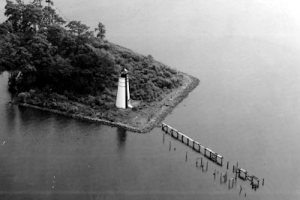
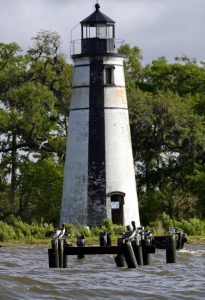 z
z

